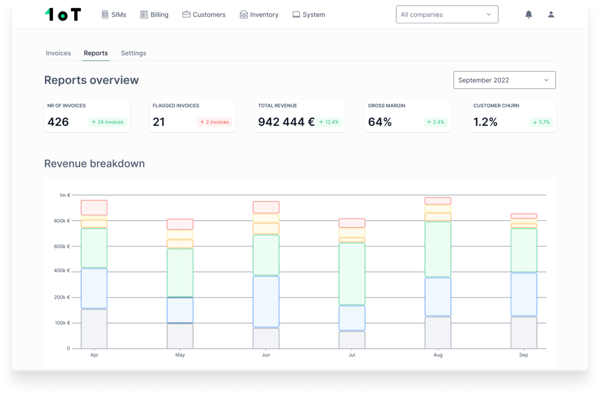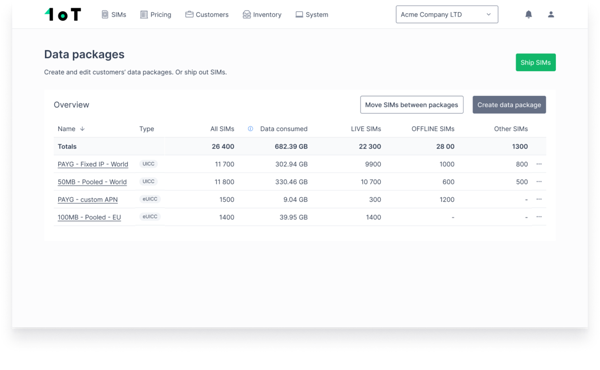Connectivity Management Platforms (CMP) have a diverse group of stakeholders who have varying expectations. In the first part of this two-part series, we focused on the expectations of modern CMPs from an enterprise perspective.
In this post, we will examine the topic from the point of view of connectivity service providers.
As the creators of 1oT Terminal, we have gained valuable insights into how CMPs should facilitate back-office processes and contribute to the growth of customers and subscriptions.
And through collaborations with telecoms who have licensed 1oT Terminal, we have gained valuable insights into the expectations of traditional mobile network operators.
Let's explore the top 5 expectations of M(V)NOs for CMPs.
Scalable customer management and support
M(V)NOs expect their chosen CMP to provide a scalable customer management and support solution for their IoT business.
This is crucial as their goal is to provide excellent service to their customers without the need for a large support staff available at all times. Thus, the CMP should be able to streamline and automate processes that make it easier for M(V)NOs to manage their IoT customers more efficiently and cost-effectively.
For example, a self-service solution like 1oT Terminal can reduce the overhead cost of the support team and the number of personnel needed for IoT business line management.
The CMP should provide a user-friendly onboarding process that enables customers to onboard themselves with minimal help from the M(V)NO. Introducing a new IoT platform to customers can be time-consuming, often requiring a dedicated team to walk them through its features and explain how it works. This takes up a lot of resources that could be better used elsewhere.
At 1oT, we understand M(V)NOs' expectations that their customers can onboard themselves with minimal help. 1oT Terminal is a self-service platform that lets M(V)NOs create access for new customers, enabling them to manage their own SIMs.
In conclusion, M(V)NOs expect their CMP to provide a scalable customer management and support solution that streamlines and automates processes, reduces overhead costs, and provides a user-friendly onboarding process.
Easy monitoring & reporting capabilities
M(V)NOs operating in the IoT space require a modern platform that provides easy monitoring and reporting capabilities to make informed business decisions about their IoT strategy. These capabilities are crucial for the success of their IoT business and staying competitive in the rapidly evolving IoT landscape.
Automated reporting is an essential feature of a modern CMP that allows M(V)NOs to easily track their IoT traffic, identify scaling/winding down customers, determine countries/networks with the highest traffic, identify popular use cases, and calculate revenue per customer.
These insights enable M(V)NOs to make data-driven decisions and optimize their IoT business operations. They can identify trends and patterns that might not be apparent otherwise, which can help them stay competitive in the rapidly evolving IoT landscape.
In addition, automated reporting streamlines the reporting process and reduces the risk of errors caused by manual data entry. It saves time and resources, allowing M(V)NOs to focus on delivering better customer service, expanding their offerings, and growing their businesses.
To summarize, automated monitoring and reporting capabilities are crucial features that a modern CMP should provide to M(V)NOs operating in the IoT space. These features enable M(V)NOs to make informed business decisions, optimize their IoT business operations, and stay ahead of the competition in the rapidly evolving IoT landscape.
Management of custom network services & product configurations
MVNOs typically seek standardized services, but as more customers require unique arrangements, such as custom pricing or dedicated IP ranges, due to IoT use cases and innovations, it's important to have the ability to create custom configurations and changes via a CMP.
These requests often come from large enterprises that require custom solutions for different deployments rather than for all of their SIMs. Ideally, customers should be able to manage these changes themselves, but if business processes require it, account managers can also help and monitor them.
Future-proofing for the future of IoT
It's vital for MVNOs to keep pace with the ever-evolving IoT landscape. If your existing platform can not keep up with the evolving IoT landscape, you risk losing customers and increasing pressure to replace a CMP after a few years.
We have developed a 1oT Terminal for our customers, and since we are the first and most important customer of the platform, 1oT Terminal is updated almost weekly. We design Terminal based on our customers' experience and market insights.
Supporting the rapid growth of IoT
Scalability is also an important factor to consider. As the number of IoT customers grows, the CMP should be able to scale up accordingly. This means that the CMP should be able to support a large number of IoT devices and SIMs without compromising the quality of service.
It should also be able to handle the increased traffic and data generated by these devices without slowing down or crashing.
As we wrote in the previous blog post, In today's fast-paced IoT world, CMPs are expected to operate at lightning speed, whether it involves loading pages, executing specific actions, or fixing error messages.
1oT Terminal is specifically designed for IoT applications, considering the requirements of both the device and connectivity aspects of the industry. If it could be helpful for your IoT business, you can visit the product page or contact licensing@1oT.com.






